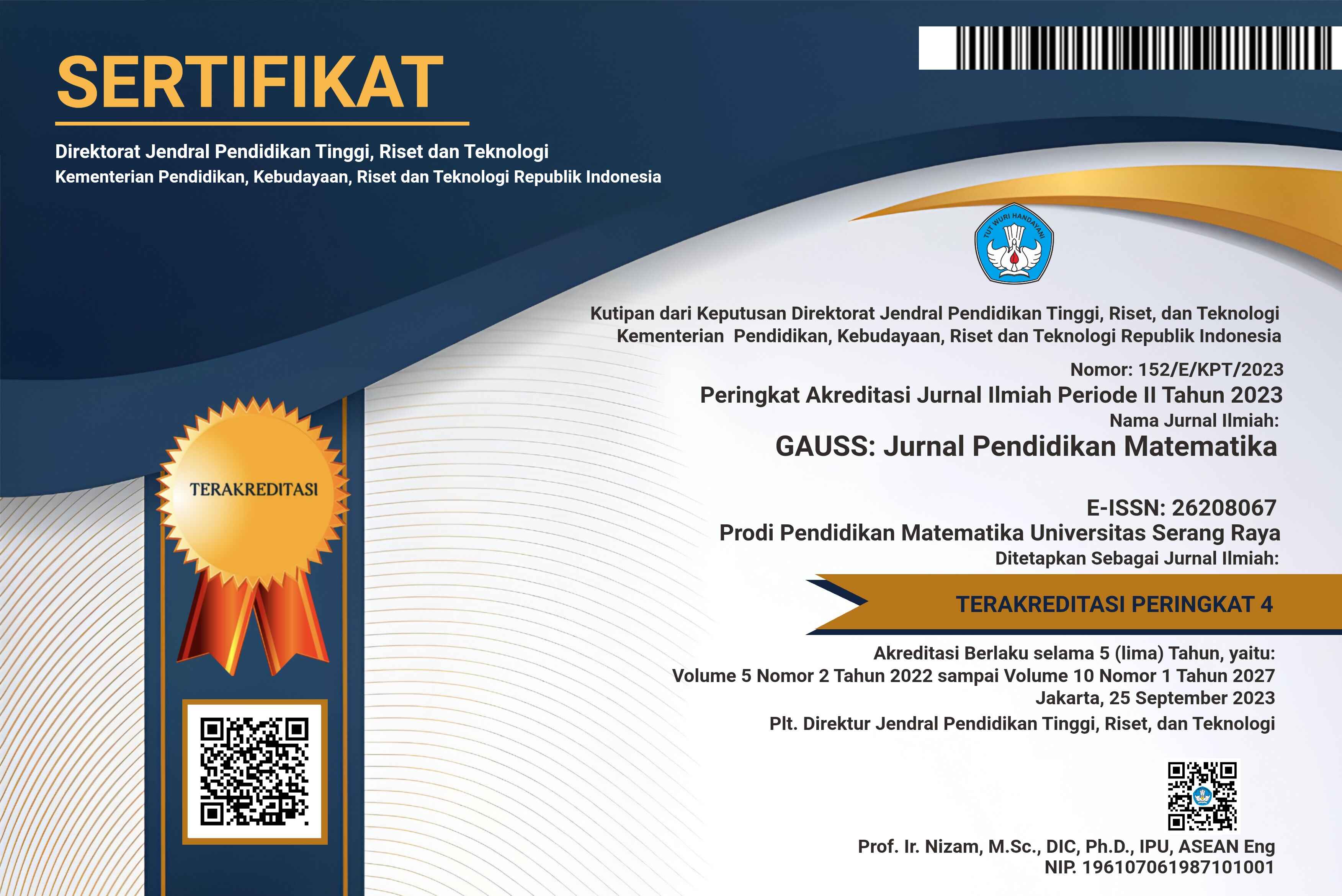Etnomatematika pada Tari Rudat Lombok: Analisis Kemampuan Metakognisi Matematis Siswa
DOI:
https://doi.org/10.30656/gauss.v8i1.10654Abstract
Abstrak
Tujuan penelitian ini adalah mengkaji etnomatematika pada tari rudat Lombok dan menganalisis kemampuan metakognisi siswa dalam menyelesaikan soal matematika berbasis etnomatematika tari rudat Lombok. Pendekatan yang digunakan adalah kualitatif dengan jenis etnografi dan deskriptif. Data dikumpulkan melalui observasi, wawancara, dan tes tulis. Teknik analisis data melalui tiga tahapan yaitu reduksi data, penyajian data, dan verifikasi data. Hasil penelitian menunjukkan bahwa pada tari rudat Lombok terdapat aktivitas-aktivitas matematika. Selain itu, terdapat konsep matematika pada gerakan penari, alat musik, serta formasi penari, antara lain konsep garis dan sudut, geometri dimensi dua dan tiga. Temuan etnomatematika tersebut dijadikan soal untuk menganalisis kemampuan metakognisi siswa kelas VII di MTs Jamiatul Mu’min sebanyak 16 siswa. Ada 3 variasi siswa dalam menyelesaikan soal yaitu siswa dengan kemampuan metakognisi tinggi mampu menyelesaikan masalah melalui tahapan perencanaan, pemantauan, dan evaluasi. Kemampuan sedang sampai pada tahapan perencanaan dan pemantauan meskipun belum maksimal, serta siswa dengan kemampuan rendah hanya pada tahap perencanaan tetapi kurang dalam merepresentasikan maksud soal.
Kata kunci: Etnomatematika, Tari Rudat, Kemampuan MetakognisiAbstract
The purpose of this study was to examine ethnomathematics in the Lombok rudat dance and analyze students' metacognitive abilities in solving ethnomathematics-based mathematics problems in the Lombok rudat dance. The approach used was qualitative with ethnographic and descriptive types. Data were collected through observation, interviews, and written tests. The data analysis technique went through three stages, namely data reduction, data presentation, and data verification. The results showed that there were mathematical activities in the Lombok rudat dance. In addition, there are mathematical concepts in the movements of dancers, musical instruments, and dancer formations, including the concepts of lines and angles, two- and three-dimensional geometry. The ethnomathematic findings were used as questions to analyze the metacognitive abilities of 16 grade VII students at MTs Jamiatul Mu'min. There were 3 variations of students in solving problems, namely students with high metacognitive abilities were able to solve problems through the planning, monitoring, and evaluation stages. Moderate abilities reached the planning and monitoring stages although not yet optimal, and students with low abilities were only at the planning stage but were less able to represent the intent of the problem.
Keywords: Ethnomathematics, Rudat Dance, Metacognitive Ability
Downloads
Published
Issue
Section
License
Copyright (c) 2025 Mutiara Dwi Insani, Al Kusaeri, Nur Hardiani

This work is licensed under a Creative Commons Attribution-NonCommercial-ShareAlike 4.0 International License.
Authors who publish articles in GAUSS : JURNAL PENDIDIKAN MATEMATIKA agree to the following terms:
- Authors retain copyright and grant the journal the right of first publication with the work simultaneously licensed under a Creative Commons Attribution-ShareAlike 4.0 International License that allows others to share the work with an acknowledgment of the work's authorship and initial publication in this journal.
- Authors are able to enter into separate, additional contractual arrangements for the non-exclusive distribution of the journal's published version of the work (e.g., post it to an institutional repository or publish it in a book), with an acknowledgment of its initial publication in this journal.
- Authors are permitted and encouraged to post their work online (e.g., in institutional repositories or on their website) before and during the submission process, as it can lead to productive exchanges, as well as earlier and greater citation of published work (See The Effect of Open Access).




